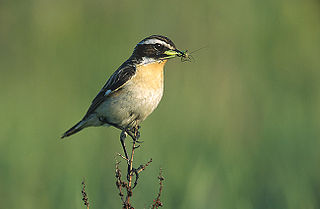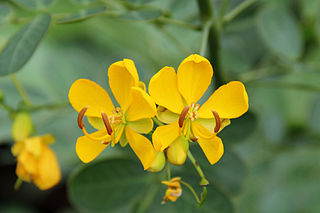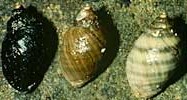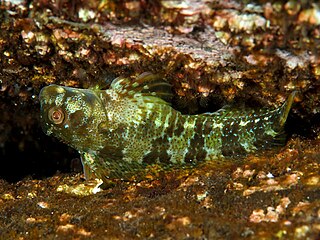Malpighia emarginata is a tropical fruit-bearing shrub or small tree in the family Malpighiaceae.

Chats are a group of small Old World insectivorous birds formerly classified as members of the thrush family Turdidae, but now considered Old World flycatchers.

Libinia emarginata, the portly spider crab, common spider crab or nine-spined spider crab, is a species of stenohaline crab that lives on the Atlantic coast of North America.

Prunus emarginata, the bitter cherry or Oregon cherry, is a species of Prunus native to western North America, from British Columbia south to Baja California, and east as far as western Wyoming and New Mexico. It is often found in recently disturbed areas or open woods on nutrient-rich soil.
Acidaspis is an extinct genus of odontopleurid trilobite from the Ordovician to Silurian of North America and Europe. Although small, it had long spines along its body.

Noronhia emarginata is a species of Noronhia native to Madagascar, now naturalized on Mauritius, Réunion and Bermuda.

Senna bicapsularis is a species of the legume genus Senna, native to northern South America, from Panama south to Venezuela and Colombia, and also the West Indies. It is naturalised and invasive in several coastal areas in the tropics, including the Galápagos Islands and New Caledonia. Common names include rambling senna, christmasbush, money bush, and yellow candlewood.

Idaea emarginata, the small scallop, is a moth of the family Geometridae. It was first described by Carl Linnaeus in his 1758 10th edition of Systema Naturae and it is found in Europe.
Microsynodontis emarginata is a species of upside-down catfish endemic to Gabon where it occurs in the Ogowe River. It was first described in 2004 by Ng Heok Hee.
Acriopsis emarginata, commonly known as the pale chandelier orchid, is a species of orchid endemic to Queensland. It is a clump-forming epiphyte with dark green leaves and curved, branching flower stems with many white and cream-coloured flowers.
P. emarginata may refer to:

Nucella emarginata, common name the emarginate dogwinkle, is a species of medium-sized predatory sea snail, a marine gastropod mollusk in the family Muricidae, the murex snails or rock snails.

Scartella emarginata is a species of combtooth blenny found in the Indian ocean. This species reaches a length of 10 centimetres (3.9 in) SL.

Oraesia emarginata is a species of moth of the family Noctuidae first described by Johan Christian Fabricius in 1794. It is found in Australia, New Caledonia, Indonesia, New Guinea, Pakistan, the Philippines, India, Sri Lanka, Sulawesi, Taiwan, China, Japan, Korea and Nepal as well as Eritrea, Ethiopia, Kenya, Namibia, Nigeria, South Africa, Tanzania, the Gambia, Uganda, Oman and Yemen.
Ornipholidotos emarginata is a butterfly in the family Lycaenidae. It is found in the Democratic Republic of the Congo and Tanzania. The habitat consists of forests.

Sybra is a genus of beetles in the family Cerambycidae, containing the following species:

Sybra umbratica is a species of beetle in the family Cerambycidae. It was described by Pascoe in 1865.

Sybra ordinata is a species of beetle in the family Cerambycidae. It was described by Bates in 1873.
Sybra pascoei is a species of beetle in the family Cerambycidae. It was described by Lameere in 1893.

Caladenia emarginata, commonly known as the pink enamel orchid, is a plant in the orchid family Orchidaceae and is endemic to the south-west of Western Australia. It is a ground orchid with a single flattened, hairy leaf and up to four glossy pink flowers. It is similar to Caladenia brunonis but is usually a shorter plant but with larger, pink flowers. It has been known as Elythranthera emarginata since 1963 but recent discoveries suggest its inclusion in the genus Caladenia.













